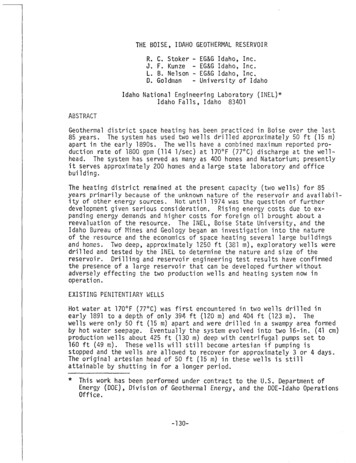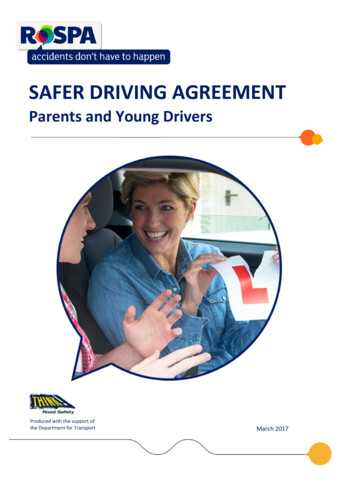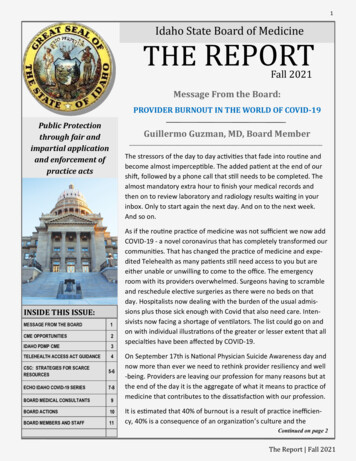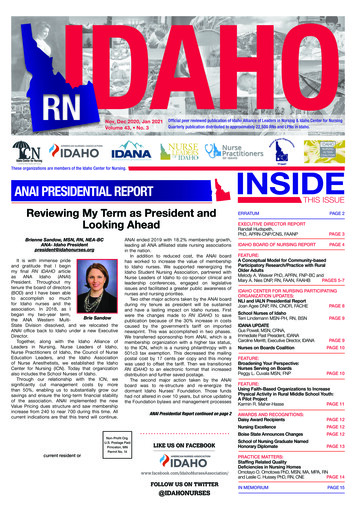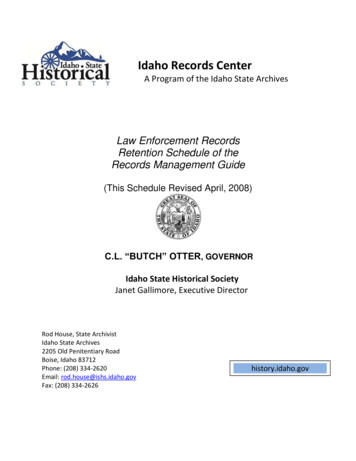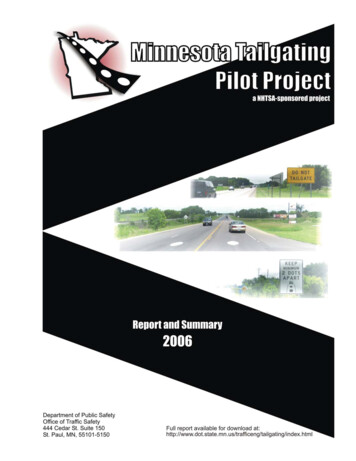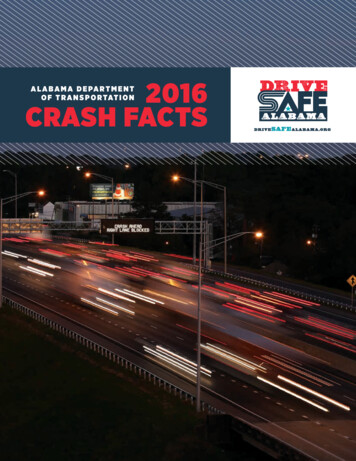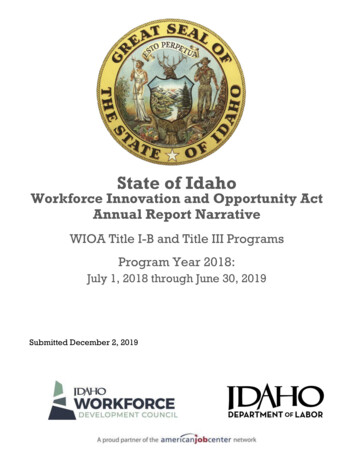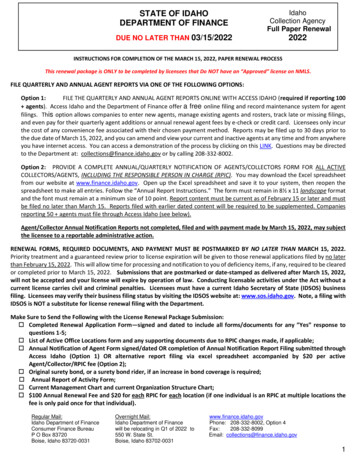
Transcription
Idaho Traffic Crashes2021Idaho Transportation DepartmentOffice of Highway Safety
IDAHO TRAFFIC CRASHES2021Prepared by the Idaho Office of Highway SafetyIDAHO TRANSPORTATION DEPARTMENTP.O. Box 7129Boise, Idaho 83707-1129(208) 334-8100Idaho Highway Safety Web Address:itd.idaho.gov/safety
IntroductionIdaho Traffic Crashes 2021 provides an annual description of motor vehicle crash characteristics forcrashes that have occurred on public roads within the State of Idaho. This document is used by state andlocal transportation, law enforcement, health, and other agencies charged with the responsibility of copingwith the increasing costs of traffic crashes. Agencies use the data to identify traffic safety problems andtarget areas for the development of crash reduction and injury prevention programs.A traffic safety problem is an identifiable subgroup of drivers, pedestrians, vehicles, or roadways that isstatistically higher in crash experience than normal expectations. Problem identification involves the studyof relationships between crashes and the population, licensed drivers, registered vehicles, vehicle milestraveled, and characteristics of specific subgroups that may contribute to crashes.This document is divided into two major sections: a statewide crash summary and a breakdown of crashesby identified problem areas. Maps displaying the approximate location of each fatal crash by transportationdistrict are found in Appendix A. Precise locations of fatal crashes cannot be determined from the maps.Appendix B is a map of crashes with wild animals. Information regarding crashes on the State HighwaySystem is available in Appendix C. A five-year fatal and injury crash history is contained in three tables inAppendix D. A twenty-five year history of fatalities and the fatality rate per 100 million annual vehiclemiles traveled is provided in Appendix E.Idaho Traffic Crashes 2021 is organized to reflect the adoption of focus areas by the Idaho Traffic SafetyCommission for the Highway Safety Grant Programs. The focus areas include: Impaired Driving, SafetyRestraint Usage, Youthful Drivers, Aggressive Driving, Distracted Driving, Emergency Medical Services,Pedestrians, Bicyclists, and Motorcyclists. These focus areas align with Idaho’s Strategic Highway SafetyPlan.Explanation of DataThe source for crash information is the Idaho Transportation Department Statewide Crash Database. Thedatabase consists of crash reports completed by all law enforcement agencies in Idaho. All lawenforcement agencies use a standard crash reporting software program to enter the data and electronicallysubmit the data to the Department, as designated in Idaho Code 49-1307. The resulting numbers areconservative since the database consists of only crashes investigated by law enforcement officers. Prior to2006, only crashes resulting in injury or death of any person, or damage to the property of any one personin excess of 750 were included. The law was amended in 2006 to crashes resulting in excess of 1,500property damage to any one person. Crashes resulting in injury or death remained unchanged. Crashesthat are excluded include those that do not occur on a public roadway, occur on a roadway on privateproperty, or are intentional acts.When examining any of the statistics herein, it is important to distinguish between the three different levelsof crash data: the crash level, the unit level, and the person level. For example, location, date, time, severity,and weather conditions are specific to the entire crash; vehicle type, extent of deformity, contributingcircumstances, and events are specific to each unit in the crash; and lastly, age, gender, injury type, andprotective device use are specific to each person involved in the crash. Each crash must involve at leastone motor vehicle and each motor vehicle contains any number of people, including zero. Each crash isclassified by the most severe injury that resulted from the crash. Therefore, each fatal crash resulted in atleast one fatality but may have also produced any number and combination of additional fatalities andinjuries.The Division of Motor Vehicles (Idaho Transportation Department) provides information on licenseddrivers, registered motor vehicles, driver’s license suspensions, and driver’s license convictions. TheTraffic Survey Section (Idaho Transportation Department) provides the annual vehicle miles of travel. The-1-
Bureau of Criminal Identification (Idaho State Police) provides information regarding DUI arrests. Othersources of information that support this document are referenced.Current year data is compared to data from the prior year to identify simple percentage changes eitherupward or downward. The average change over the prior four years is given to provide an additionalperspective.If you have any questions or suggestions concerning Idaho Traffic Crashes 2021, contact the Office ofHighway Safety. Contact information is available on the title page at the front of this document.-2-
Glossary of TermsThe following terms are used throughout this report and are provided to clarify the meaning of the data.BICYCLE (PEDACYCLE): Every vehicle propelledexclusively by human power upon which anyperson may ride, having two tandem wheels,except scooters and similar devices.INJURY: Bodily harm to a person as a result of amotor vehicle crash.INJURY SEVERITY:CHILD SAFETY SEAT: A car safety seat thatmeets the requirements of Federal Motor VehicleStandard 213. As of July 1, 2005, every childunder the age of seven that is transported in amotor vehicle must be properly restrained insuch a seat.Fatal Injury (Death) - Any injury that results inthe death of a person within 30 days of the crashin which the injury was sustained.DRIVER (OPERATOR): Every person who is inactual physical control of a motor vehicle upon ahighway.Suspected Minor Injury (Visible Injury) (Nonincapacitating, Evident Injury) - Any injury, otherthan a fatal injury or incapacitating injury, whichis evident to observers at the scene of the crash inwhich the injury occurred.CRASH (TRAFFIC): An unintended event thatcauses a death, injury, or damage and involves amotor vehicle on a public roadway.FATAL CRASH: Any motor vehicle crash thatresulted in the death of one or more persons dueto injuries received from the crash within 30 daysof the crash.FATALITY: An individual involved in a motorvehicle crash who died within 30 days of thecrash as a result of injuries sustained in the crash.HEAVY TRUCK: A motor vehicle exceeding 8,000pounds gross weight; has two or more wheels peraxle or has more than two axles; and is designed,used, or maintained primarily for thetransportation of property.IMPAIRED DRIVING CRASH: Any crash in whichan officer indicated on the crash report thatalcohol or drugs were used, or were acontributing factor in the crash.-69-Suspected Serious Injury (Incapacitating Injury) Any injury, other than a fatal injury, whichprevents the injured person from walking,driving, or normally continuing the activities theperson was capable of performing before theinjury occurred.Possible Injury - Any injury reported or claimedwhich is not a fatal injury, incapacitating injury,or non-incapacitating, evident injury.LICENSED DRIVER: A person who is licensed bya State to operate a motor vehicle on publichighways. In Idaho, a person who has reached theage of 15 years, and who has successfullycompleted an approved driver's training course,may apply for a class "D" license. Drivingprivileges are restricted to daylight hours onlyuntil the age of 16.LOCAL ROAD: Any road other than an Interstate,U.S., or State Highway.MOTOR VEHICLE: Every motorized vehiclewhich is self-propelled or propelled by electricpower obtained from overhead trolley wires butnot operated upon rails except motorizedwheelchairs.
Glossary of Terms (Continued)OCCUPANT: A person who is in or on a motorvehicle.PASSENGER: Any occupant of a vehicle otherthan its driver.PEDESTRIAN: Any person afoot and any personoperating a wheelchair or motorized wheelchair.PROPERTY DAMAGE ONLY: Any crash in whichthere was property damage of 751 or more toany one person but no injuries or fatalities priorto 2006. The threshold was increased to 1,501or more in 2006 and later.RURAL:All areas, incorporated andunincorporated, with a population of less than5,000 people.SEAT BELT: A device designed to hold theoccupant of a motor vehicle in the seat of a vehiclethat was manufactured with safety belts incompliance with Federal Motor Vehicle safetystandard number 208. Each occupant of a motorvehicle which has a gross vehicle weight of notmore than 8,000 pounds, and so manufactured,shall have a seat belt properly fastened about hisbody at all times when the vehicle is in motion.-70-STATE HIGHWAY SYSTEM:Includes allInterstate, U.S. and State highways (i.e. I-84, US95, SH 75)TRACTOR/BOBTAIL: A motor vehicle designedand used primarily for drawing other vehicles butnot so constructed as to carry a load other thanpart of the weight of the vehicle and load sodrawn.URBAN:Any incorporated area with apopulation of 5,000 or more.VEHICLE: Every device in, upon, or by which anyperson or property is or may be transported ordrawn upon a highway, excepting devices usedexclusively upon stationary rails or tracks.VIOLATION: A conviction of a misdemeanorcharge involving a moving traffic violation, or anadmission or judicial determination of thecommission of an infraction involving a movingtraffic infraction, except bicycle infractions.
References and Notes1. U.S. Department of Transportation, Federal Highway Administration, Memorandum: Guidance onTreatment of the Economic Value of a Statistical Life (VSL) in U.S. Department of Transportation Analyses– 2014 Adjustment, June 13, 2014.2. Blincoe, L. J., Miller, T. R., Zaloshnja, E., & Lawrence, B. A. (2015, May (Revised)). The economic andsocietal impact of motor vehicle crashes, 2010. (Report No. DOT HS 812 013). Washington, DC: NationalHighway Traffic Safety Administration.3. Kahane, Charels J., Fatality Reduction by Safety Belts for Front-Seat Occupants of Cars and Light Trucks,December 2000, Washington D.C.: U.S Department of Transportation, National Highway Traffic SafetyAdministration, DOT HS 809 199.4. Haddon and S. Baker, "Injury Control", Chapter 8, Preventive and Community Medicine, Edited by C.Clark and B. MacMahon, Title Brown and Co., New York, 1987.5. Highway District boundaries: District I - North Idaho (Boundary, Bonner, Kootenai, Benewah, andShoshone Counties), District II - North Central Idaho (Latah, Nez Perce, Lewis, Clearwater, and IdahoCounties), District III - Southwest Idaho (Adams, Valley, Washington, Payette, Gem, Boise, Canyon, Ada,Owyhee, and Elmore Counties), District IV - South Central Idaho (Camas, Blaine, Gooding, Lincoln,Minidoka, Jerome, Twin Falls, and Cassia Counties), District V - Southeast Idaho (Bingham, Power,Bannock, Caribou, Oneida, Franklin, and Bear Lake Counties) and District VI - Eastern Idaho ( Lemhi,Custer, Butte, Clark, Fremont, Jefferson, Madison, Teton, and Bonneville Counties).6. Dean, J. Michael, Reading, James C., and Nechodom, Patricia J., Overreporting and Measured Effectivenessof Seat Belts in Motor Vehicle Crashes in Utah, Transportation Research Record 1485, TransportationResearch Board, National Research Council, National Academy Press, 1995.-71-
The source for crash information is the Idaho Transportation Department Statewide Crash Database. The database consists of crash reports completed by all law enforcement agencies in Idaho. All law enforcement agencies use a standard crash reporting software program to enter the data and elect ronically
